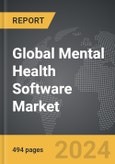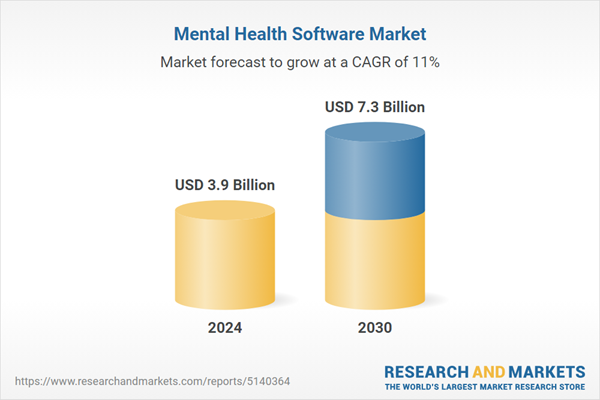Global Mental Health Software Market - Key Trends & Drivers Summarized
What is Mental Health Software, and How Does It Serve Its Users?
Mental health software is a specialized tool designed to manage, monitor, and support mental health treatment and administration. It includes functionalities such as electronic health records (EHR), patient scheduling, billing, and teletherapy capabilities. This software provides healthcare professionals with the means to handle patient data securely and enhances patient engagement through more accessible communication channels. With the rise in mental health issues globally, such software plays a crucial role in facilitating efficient service delivery by enabling therapists and psychiatrists to track patient progress, schedule appointments, and conduct remote therapy sessions. The integration of data analytics tools further allows practitioners to analyze trends and outcomes, ultimately leading to better and more personalized care.How Does Mental Health Software Enhance Treatment Accessibility and Efficiency?
This technology has significantly transformed the accessibility of mental health services by enabling remote therapy sessions that overcome geographical barriers. This feature is particularly beneficial in rural or underserved areas where mental health professionals are scarce. Additionally, mental health software simplifies the management of healthcare records, allowing for easy updates and instant access, which is vital for the continuity of care. Such streamlined management not only saves time but also ensures that the focus remains on patient care rather than administrative tasks. Furthermore, the software's capacity to integrate with other healthcare systems promotes a holistic approach to health management, where mental health care can align more closely with other medical treatments.Who Are the Key Beneficiaries of Mental Health Software?
The primary beneficiaries of mental health software are mental health professionals, including psychologists, therapists, and social workers, who utilize these tools to manage patient records, schedule appointments, and deliver treatment more effectively. Patients also benefit significantly, as this software often includes patient portals that offer educational resources, self-monitoring tools, and direct communication with their caregivers. Such features empower patients by giving them active roles in their recovery processes and better accessibility to support. Moreover, healthcare administrators find mental health software invaluable for its ability to streamline operations, maintain compliance with health regulations, and manage financial aspects of the practice.What Drives the Growth in the Mental Health Software Market?
The growth in the mental health software market is driven by several factors, including the increasing prevalence of mental health disorders, the growing demand for telehealth services, and the ongoing digitization of healthcare. The COVID-19 pandemic has particularly highlighted the need for remote healthcare services, accelerating the adoption of teletherapy and other online treatment solutions. Advances in technology, such as AI and machine learning, are also enhancing the capabilities of mental health software, making it more efficient at diagnosing and managing mental health conditions. Additionally, as societal awareness and de-stigmatization of mental health issues increase, more individuals are seeking treatment, further stimulating demand for innovative and effective digital health solutions. Consumer behavior that leans towards personalized and accessible healthcare, combined with healthcare providers' need for efficient practice management tools, continues to propel the expansion of this market.Report Scope
The report analyzes the Mental Health Software market, presented in terms of market value (USD). The analysis covers the key segments and geographic regions outlined below.- Segments: Component (Software, Support Services); Function (Clinical, Administrative, Financial); End-Use (Providers, Payers, Patients).
- Geographic Regions/Countries: World; USA; Canada; Japan; China; Europe; France; Germany; Italy; UK; Spain; Russia; Rest of Europe; Asia-Pacific; Australia; India; South Korea; Rest of Asia-Pacific; Latin America; Argentina; Brazil; Mexico; Rest of Latin America; Middle East; Iran; Israel; Saudi Arabia; UAE; Rest of Middle East; Africa.
Key Insights:
- Market Growth: Understand the significant growth trajectory of the Software segment, which is expected to reach US$6.2 Billion by 2030 with a CAGR of 11.2%. The Support Services segment is also set to grow at 10.2% CAGR over the analysis period.
- Regional Analysis: Gain insights into the U.S. market, valued at $1.3 Billion in 2024, and China, forecasted to grow at an impressive 12.9% CAGR to reach $466.7 Million by 2030. Discover growth trends in other key regions, including Japan, Canada, Germany, and the Asia-Pacific.
Why You Should Buy This Report:
- Detailed Market Analysis: Access a thorough analysis of the Global Mental Health Software Market, covering all major geographic regions and market segments.
- Competitive Insights: Get an overview of the competitive landscape, including the market presence of major players across different geographies.
- Future Trends and Drivers: Understand the key trends and drivers shaping the future of the Global Mental Health Software Market.
- Actionable Insights: Benefit from actionable insights that can help you identify new revenue opportunities and make strategic business decisions.
Key Questions Answered:
- How is the Global Mental Health Software Market expected to evolve by 2030?
- What are the main drivers and restraints affecting the market?
- Which market segments will grow the most over the forecast period?
- How will market shares for different regions and segments change by 2030?
- Who are the leading players in the market, and what are their prospects?
Report Features:
- Comprehensive Market Data: Independent analysis of annual sales and market forecasts in US$ Million from 2024 to 2030.
- In-Depth Regional Analysis: Detailed insights into key markets, including the U.S., China, Japan, Canada, Europe, Asia-Pacific, Latin America, Middle East, and Africa.
- Company Profiles: Coverage of players such as Cerner Corporation, Allscripts Healthcare Solutions, Inc., Advanced Data Systems Corporation (ADS), Drchrono, Inc., Compulink Healthcare Solutions and more.
- Complimentary Updates: Receive free report updates for one year to keep you informed of the latest market developments.
Some of the 143 companies featured in this Mental Health Software market report include:
- Cerner Corporation
- Allscripts Healthcare Solutions, Inc.
- Advanced Data Systems Corporation (ADS)
- Drchrono, Inc.
- Compulink Healthcare Solutions
- Core Solutions, Inc.
- Compliancy Group
- BestNotes
- CareVoyant Inc.
- AdvancedMD, Inc.USA
- Alleva
- EnSoftek, Inc.
- EMR-BEAR
- eHana
- Adracare
This edition integrates the latest global trade and economic shifts into comprehensive market analysis. Key updates include:
- Tariff and Trade Impact: Insights into global tariff negotiations across 180+ countries, with analysis of supply chain turbulence, sourcing disruptions, and geographic realignment. Special focus on 2025 as a pivotal year for trade tensions, including updated perspectives on the Trump-era tariffs.
- Adjusted Forecasts and Analytics: Revised global and regional market forecasts through 2030, incorporating tariff effects, economic uncertainty, and structural changes in globalization. Includes historical analysis from 2015 to 2023.
- Strategic Market Dynamics: Evaluation of revised market prospects, regional outlooks, and key economic indicators such as population and urbanization trends.
- Innovation & Technology Trends: Latest developments in product and process innovation, emerging technologies, and key industry drivers shaping the competitive landscape.
- Competitive Intelligence: Updated global market share estimates for 2025, competitive positioning of major players (Strong/Active/Niche/Trivial), and refined focus on leading global brands and core players.
- Expert Insight & Commentary: Strategic analysis from economists, trade experts, and domain specialists to contextualize market shifts and identify emerging opportunities.
Table of Contents
Companies Mentioned (Partial List)
A selection of companies mentioned in this report includes, but is not limited to:
- Cerner Corporation
- Allscripts Healthcare Solutions, Inc.
- Advanced Data Systems Corporation (ADS)
- Drchrono, Inc.
- Compulink Healthcare Solutions
- Core Solutions, Inc.
- Compliancy Group
- BestNotes
- CareVoyant Inc.
- AdvancedMD, Inc.USA
- Alleva
- EnSoftek, Inc.
- EMR-BEAR
- eHana
- Adracare
Table Information
| Report Attribute | Details |
|---|---|
| No. of Pages | 494 |
| Published | December 2025 |
| Forecast Period | 2024 - 2030 |
| Estimated Market Value ( USD | $ 3.9 Billion |
| Forecasted Market Value ( USD | $ 7.3 Billion |
| Compound Annual Growth Rate | 11.0% |
| Regions Covered | Global |









